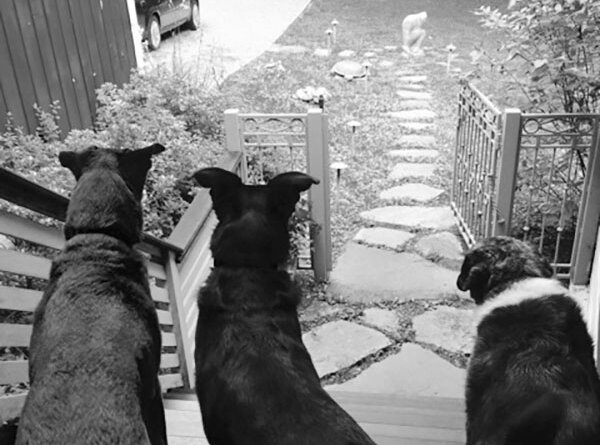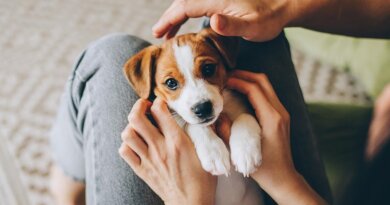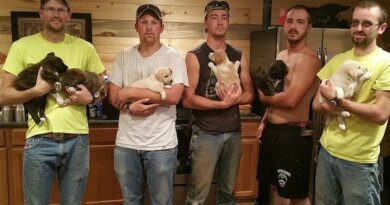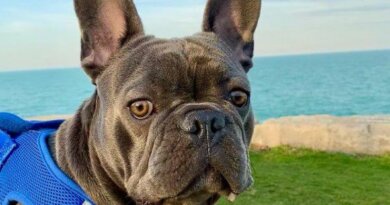The Cost of Rescue | The Bark
After the last of our three dogs died in March 2020, I felt their absence in my body. We had adopted them when our twins were in middle school. For 14 years, we were a family of seven. Now, everyone in New York had to shelter at home, and my husband and I found ourselves shut in, our grief ghosting throughout the house.
Our sons, who are now in their 20s, left their apartments in the city to stay with us in our wooded suburb. They helped mitigate my sorrow. Now and again, I talked about adopting a new dog––I didn’t want to be without one––but my husband likened the idea to getting married within a few months after losing a spouse. It was an act of betrayal.
I told myself to wait, be patient. I told myself that with so much suffering in the news, some of it raging, we had what we needed. I cooked and cleaned for my family. I worked, correcting proofs for a book that was to be published, and, to tap into joy, I danced on Zoom.
My husband was no longer going to work. The indoor tennis facility where he teaches had closed. He spent most of his time on the phone, figuring out what to do with his father, who was suffering from dementia and living in an assisted living facility in Los Angeles. As such places were becoming hot spots, he wanted his stepmother to bring his father back to their house. She refused. In April, he died of Covid-19, and we joined the thousands of others who couldn’t sit by a loved one and say good-bye.
GET THE BARK NEWSLETTER IN YOUR INBOX!
Sign up and get the answers to your questions.
His father had also been a dog lover. When he lived in New York, he’d visit us on the weekends, as happy to see our dog at the time, a German Shepherd mix, as he was to see any of us. He was in his 70s then, tall and slim, and he’d get down on his hands and knees to kiss the dog on her bed. She was aggressive around most people but, with my father-in-law, she’d close her eyes and lick him on the face, mirroring one of his strongest attributes, loyalty.
The love for a dog is as pure to a dog-owner as it is incomprehensible to a non-dog-owner. Perhaps because, as Sigrid Nunez writes in her novel The Friend, dogs “may, in their mute, unfathomable way, know us better than we know them.”
We had adopted the Shepherd from a shelter in North Carolina where we were living as newlyweds. I brought an oversized Yorkie into the marriage, an impulsive $100 purchase from a cat store––the shop owner was selling off his dog’s litter. My husband picked out the Shepherd, who was around 10 months old, because she reminded him of his ex-girlfriend’s dog. I ignored the why. I wanted a second dog, though I would have chosen the one who bounced joyfully when we approached.
The Shepherd lay still in her cage and, later, slinked around our yard, carrying her beauty without a glimmer of confidence. She didn’t warm up to our friends, and the one time we left her alone with our Yorkie, she tore a hole in his neck.
When, years later, she bit one of our 18-month-old twins, everyone thought we’d get rid of her, but the bite was superficial, and we, the fairly new parents, worried about the dog’s fate. We forged ahead with extreme caution. We kept her away from the boys until they were old enough to respect her space, and, like magic, she fell in love with them. But we never left her alone with our Yorkie again.
After the death of his father, my husband grew quieter. I hoped he might be ready to save another dog. I flooded his inbox with photos of shelter puppies, and, within a week, he gave in. Puppies were in demand, a positive for rescue organizations. I filled out several applications, always too late for the dog we wanted.
Late one night, I received a notification about two new puppies in Texas, but I was too tired to fill out the application. My husband offered to do it. They were older puppies, sisters at a shelter in Bandera County. In a video on the rescue site, the two girls looked timid, one hiding behind the other. They were, at four or five months old, believed to be from an unwanted litter, the mother a black Labrador, the father a Great Pyrenees.
The next morning, we were surprised to get a call from the shelter confirming our willingness to take both. My husband said yes. I said yes, only to question myself out loud: Should we really get both? They’re so big. Yes, my sons said. It’ll be fine once they’re here, my husband said. As he seemed calm––and I longed for him to feel lighter––I set aside my doubts. When we learned that all transports to our area were booked until June, I started worrying again: the longer a dog lives in a shelter the harder it can be to knead out tough behavioral knots. I thought of our Shepherd.
We have more than two acres surrounded by a deer fence and, two years ago, we had gardens planted. The gardener had been to our house just a couple of weeks before the new puppies were scheduled to arrive. Flowers abounded like colorful fairies, grasses like silk feathers. We also have meadows in need of curating, where hundreds of black-eyed susans were beginning to bloom. The puppies would have room to roam.
In early June, we drove for an hour to the large parking lot of a closed shopping center. Several rescue vans came and went while we waited for ours. My husband and I watched families pick up dogs of all ages and sizes. Everyone wore masks, eyes alone registering anticipation and delight.
After our transport arrived, a woman led two tall, skinny black puppies out of the van. They were frightened, and one tried to hide under the van. The woman slipped on the collars we’d brought with us. When the two wouldn’t get into our car, my husband scooped one up while I picked up the other, thinking how light she was for such a big puppy. I sat in the back with them, where, exhausted, they put their heads on my lap.
They came with the names Secret and Sadie. We kept Secret’s name. From the beginning, she was friendly and confident, while Sadie (whom we renamed Ila) was more apprehensive. Secret has the profile of a Weimaraner, her head sleek, her body long, her chest marked by a small white star. Ila is also long-bodied and long-legged, but her head is shaped more like a Labrador’s, and her chest is marked by a big white patch.
Ila’s insecurities quickly became evident. She rarely wagged her tail, and barked at our friends when they came to visit us. She became attached to me and once growled at my husband when he approached. Taken aback, he said he felt a little nervous that she might bite him. His anxiety intensified as the puppies became friskier, prancing and galloping like ponies through the gardens and meadows. What were we thinking? I asked friends. How could I have forgotten how puppies behave?
I suggested we build a dog pen, an unexpected expense. In the pen, the puppies dug holes and unearthed bottles, golf balls, stuffed animals, and a slew of unidentifiable objects. They discovered a wet area to poke around in, and I was sure they were about to dig up the skeletal remains of a deer or fox. After a tiny spring shot up from the spot one afternoon, I pictured an underground stream making way for a sinkhole.
Ila was the more erratic of the two, and my husband and sons said she was out of control. But they’re puppies, I told them. We need to train them. I found a trainer willing to social distance with us in our yard. Knowing that private sessions would add up, I found a puppy class. The cost of rescue, I thought. Lucky we can manage.
We walked the dogs to and from the pen, and on trails in nature preserves. They pulled on their leashes. Sometimes I’d trip, unaccustomed to their strength––they were already 60 pounds and only seven months old. My husband, who’s more than six feet tall, almost tripped. He said, I’m too old for this. I said, You’re not that old, but I thought, We should have taken one dog, we’re just too old for two.
During the day, I was too distracted to do any writing, which made me feel like someone I didn’t know. At night, the puppies slept in the kitchen, in separate crates, both frightened of climbing the stairs to get to our bedroom. When our sons carried them up one evening to surprise us, they slept on the bed. Such new, big creatures. Rolling around, pressing their warmth against us. It’s too soon, I thought, and I missed our three dogs. I felt disloyal to them.
In mid-July, the girlfriend of one of our sons came to live with us for two weeks. Did I know that Great Pyrenees are bred for protection? Yes, I’d read that, and Ila, not surprisingly, was excellent at it. She barked at our son’s girlfriend whenever she came into a room. At least she’s wagging her tail—that’s a good sign, I said, which didn’t reassure the girlfriend.
The barking drove us all crazy, and my husband and I fought. After the girlfriend left, quiet was restored. One morning, while the puppies lay nearby, I said to my husband, Isn’t it something that, in all this darkness, we can give these two a new life? He was still, staring at them, and finally said yes.
A few months have now passed. The dogs have grown comfortable in their new life … our new life … the one we could have never predicted. We’ve watched Secret turn into a sock collector who moans softly while waiting for food. (Yes, they both have learned to sit and wait.)
As for Ila, she’s always wagging her tail, and has a knack for finding a place to lie with a pillow for her head. And she adores my husband. He didn’t get flustered when they chewed up the bench cushions and trampled the rest of the gardens after we––after I––decided to let them roam. It was, after all, the last days of August, and fall was around the corner.
A dog can sense a fast heartbeat, smell fear. A dog can be a barometer of our equanimity. As the dogs continue to reveal themselves, we also recognize small shifts in our own behaviors after so much isolation. Today, amidst the flattened hostas, we planted daffodil and tulip bulbs in the gardens. We still have many more to plant.
For some reason, the task, one I’ve never enjoyed, is bringing me into a place of hope. My husband digs the holes, I drop in the bulbs, cover them up. Not a fair share of labor, but we’re relaxed, working together and, so far, the dogs have left the bulbs alone.
They’re lying on the deck, calm, eyes on us.
I think of Anne Carson’s poem, The Glass Essay, where she refers to Emily Brontë as the “whacher” (Brontë’s spelling):
Whacher is what she was…
She whached eyes, stars, inside, outside, actual weather.
She whached the bars of time, which broke.
She whached the poor core of the world,
wide open.
They’re beautiful animals, Secret and Ila. They’re watching us resurface.




